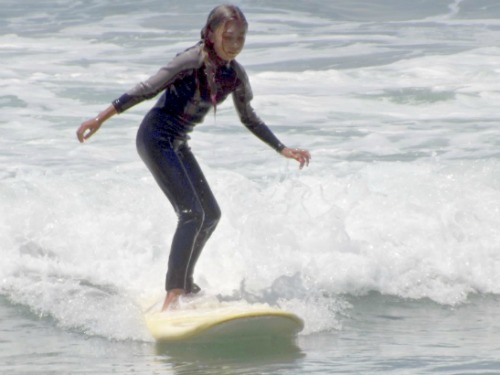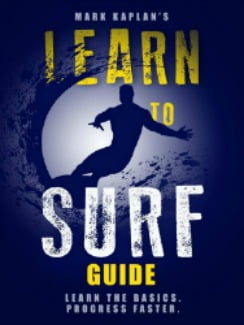How many lessons does it take to be a good surfer many students ask. A good follow up question is how good is good? My objective in surf lessons is to make a student independent of the instructor so they can practice on their own.
With regular practice, it would take a student a few years to be an advanced surfer using a short board. Not all students could make this advancement. Sometimes it is better to stick with a high volume board that keeps surfing easier or even go to a longer board. It might depend on age and fitness.

What Are the Steps of Progress?
In the first lesson a student is taught the basic fundamentals to catch waves and ride the surf board to the beach starting in shallow water and riding foam waves. These are the fundamentals that are used by advanced surfers because the basics are the way the surf board is designed to carry a body.
The beginner student learns to roll onto the surf board and paddle to catch a wave. This is not as easy as it seems. The surf board has no inclination to go straight, stay level, or get in front of waves. The student has to control all three.
The beginner student learns to pop up from a lying down position. This requires some upper body strength, flexibility, a little athletic ability, and ability to remember a sequence of small steps.
The student has to land in a perfect posture to ride the board to the beach or they fall off. This is where people learning on their own and beginners have so much difficulty. People learning on their own have no idea of what to do. Students in lessons need to have good communications between their brain and body. Many do not.
Moving On in Progress
Once a student has mastered these fundamentals, they can start paddling out to bigger waves. When they can ride the bigger foam waves, they can start catching real waves. Real waves require better timing because they arc and only stay open for a few seconds.
After catching real waves. the surfer can start learning all the maneuvers of riding real waves. Then he can start moving to a hard board that is just a little shorter than the high volume soft top he learned on. Over months, the student might start moving shorter just 6 inches at a time while keeping the width and thickness of the board.
A student who doesn’t get to practice often should remain with an 8′ soft top board. It is capable of riding real waves and doing most of the maneuvers. It remains easy to paddle and easy to ride. You don’t have to be a short board ripper to thoroughly enjoy surfing the rest of your life.
Learn More
My New Surfing Course in an E-Book plus Demo Video or Audio Version
Get the 18 Chapter, 7,500 word Course that can prepare you for a lesson or give you the fundamentals if you are going to try it on your own. 10 years of teaching 350 students a year has given me the insights on the most precise measures you must follow for success. This course is what I teach on the dry land and in water instruction. The Course includes a 15 minute video on my dry land and in water demonstration. Only $4.95
Buy the E-Book and start learning $2.99. Learn to Surf
Buy the Paperback on Amazon $7.95
Get Learn to Surf Course in 29 minute AUDIO. Great prep for a lesson, reviewing after a lesson, learning on your own, refreshing after not having surfed for a while. See Table of Contents. Only $7.95.

For Oceanside Surf Lessons, see the Home Page
See the Post Search Lessons Teach Fundamentals
See the Post Catching Real Surf Waves
See my Dry Land and in Water Demo video
See my other Surf site for more Posts
I have lowered the price of Courses and Books for the lock down price of $2.99
80 page Learn to Surf Book
![Surf Instructions Beginner to Advanced: Learn to Ride Waves by [Kaplan, Mark]](https://images-na.ssl-images-amazon.com/images/I/51HswFtoBQL.jpg)